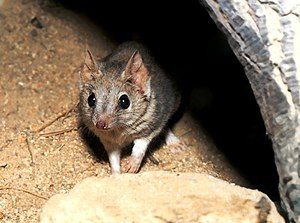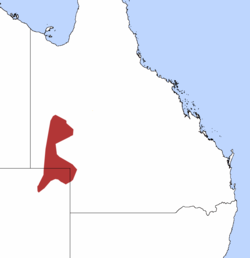Double-comb pouch mouse
| Double-comb pouch mouse | ||||||||||||
|---|---|---|---|---|---|---|---|---|---|---|---|---|

Double-comb pouch mouse ( Dasyuroides byrnei ) |
||||||||||||
| Systematics | ||||||||||||
|
||||||||||||
| Scientific name of the genus | ||||||||||||
| Dasyuroides | ||||||||||||
| Spencer , 1896 | ||||||||||||
| Scientific name of the species | ||||||||||||
| Dasyuroides byrnei | ||||||||||||
| (Spencer, 1896) |
The double-comb pouch mouse or Kowari ( Dasyuroides byrnei ) is a species of marsupial from the family of the predatory pouches (Dasyuridae). Some classifications also classify it in the genus Dasycercus .
description
Double-comb pouch mice are stocky, mouse-like animals with short legs. Her back and sides are colored gray, the belly is white. The front half of the tail is reddish in color, the rear half is covered by long black hair on the top and bottom. These hairs can be straightened up like a comb, which is also where the species owes its name. These animals reach a head body length of 14 to 18 centimeters, a tail length of 11 to 14 centimeters and a weight of 70 to 140 grams. Males are usually 30 grams heavier than females. The well-trained jaw is stocky and is designed to prey and chew the prey. The Kowaris tooth formula is: I 4 / 3- C 2 / 2- P 2-3 / 2-3- M 4/3. The flattened palate bone, which is prominently developed in many marsupials, is absent as in some other members of the Dasyuridae family
Distribution and way of life
These animals live in the Lake Eyre Basin in northern South Australia and southwest Queensland . Their habitat are dry grasslands and stone deserts with less than 250 mm of precipitation per year. They are primarily nocturnal, but can sometimes be seen sunbathing. They seek shelter in structures that they have dug themselves or that have been taken over by other animals, in which they build grass nests. Double-comb pouch mice are usually ground dwellers, but can also climb well. They are territorial and mark their territory with the secretion of their scent glands, whether they live solitary like other bag mice is not clear, since several animals could be kept together in captivity.
They feed exclusively on carnivore . Their diet consists of insects, spiders, small vertebrates such as rodents, birds and lizards, and carrion.
Reproduction
After a gestation period of 30 to 36 days, the female gives birth to three to seven (usually five or six) young animals twice a year. They spend the first eight weeks of their lives in their mother's pouch, after which they also ride on her back. At three months they are weaned and independent and at eight months they are sexually mature. Life expectancy is up to four years in nature, up to seven years in human care. In Germany, Kowaris are maintained in Leipzig, Frankfurt, Hof and Magdeburg.
threat
The reenactment by introduced predators such as the red fox and the conversion of their habitat into pastures represent the main threat to the double-crested pouch mouse. In part of its range (for example the southern Northern Territory it has disappeared), overall it is considered endangered by the IUCN ( "Vulnerable") listed.
supporting documents
- ↑ Phil Myers: [1] on the Animal Diversity Web of the University of Michigan Museum of Zoology. Retrieved September 2, 2012.
- ↑ Richard Weigl: Longevity of Mammals in Captivity; from the Living Collections of the World . Kleine Senckenberg-Reihe 48, Stuttgart 2005, ISBN 3-510-61379-1 .
- ↑ Entry on Zootierliste.de; accessed on June 15, 2016
literature
- Ronald M. Nowak: Walker's Mammals of the World. Johns Hopkins University Press, Baltimore 1999, ISBN 0-8018-5789-9 .
Web links
- Dasyuroides byrnei in the endangered Red List species the IUCN 2008 Posted by: M. McKnight u. a., 2008. Retrieved January 2, 2009.

